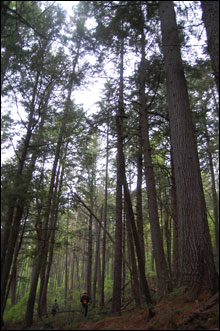
FELLING THE GIANTS? Plum Creek thinks
these beautiful trees would make lovely
lumber. |
You would think the Plum Creek Timber Company would be doing all it could to avoid negative publicity right now.
The Seattle-based company’s proposal to build nearly 1000 homes and major resort destinations in the Moosehead Lake region has generated enormous controversy across the state, and still hasn’t been approved by the Maine Land Use Regulation Commission (LURC). Plum Creek has worked hard to put a green face on the plan, most notably by touting the benefits of the plan’s “conservation framework,” which would protect more than 400,000 acres from development, though the framework would not prevent logging, mining, or water extraction on much of the land. (For more on the project, see "Up Plum Creek Without a Paddle," by Yanni Peary, November 28, 2007.)
But now Roger Merchant, a forester and educator at the University of Maine Cooperative Extension in Dover-Foxcroft, has blown the whistle on Plum Creek’s plans to log more than 250 acres of what may be old-growth forest between Monson and Greenville this summer.
Merchant approached Plum Creek with his concerns about the proposed cut last fall, but the company didn’t change its plans. So, last week Merchant sent a letter and photographs to LURC and a handful of state environmental agencies, calling for the site’s conservation and suggesting it as a potential eco-tourism spot.
Merchant is hardly your stereotypical tree-hugger — he supports Plum Creek’s plan for the North Woods and managed 100,000 acres of forest for the Dead River Company’s timber division in the 1960s — but he says this site is special. It shows no sign of ever having been logged and is home to many trees that are well over 200 years old.
“I’ve been walking through those woods for 15 years, and this is different,” he says.
Merchant’s letter caught the attention of the Maine Natural Areas Program, which requested permission from Plum Creek to visit the land last week, and are waiting to hear when they might be allowed to do so. The Native Forest Network is also investigating the situation, and, on Friday, Plum Creek asked a forest ecologist from the independent Manomet Center for Conservation Sciences, based in Brunswick, to visit the site and make recommendations on how to proceed.
Plum Creek’s forester, Mark Doty, confirmed that Plum Creek plans to cut the parcel in the next few months. The trees there are certainly old, he says, but he says he couldn’t say whether or not they are technically old-growth until a company forester formally evaluates the site and makes a plan for how to proceed with the cut. Doty says the company always follows Manomet’s guidelines — which are designed to protect biodiversity during forestry — when logging.
Andy Whitman, the Manomet forest ecologist who will visit the site next month, defines old-growth stands as being made up of mostly 200- to 300-year-old trees. He says Manomet recommends protecting old-growth forest because it contains unique biodiversity, is socially and spiritually important to many people, and is a point of reference that shows what a forest looks like without human intervention.
Whitman says he thinks it is unlikely that the land in question is truly old-growth forest. “I’d be surprised, but I’m not ruling it out,” he says. If it is, he’ll recommend leaving it untouched. If it’s simply older forest, he may advise Plum Creek to leave patches intact and cut half of the rest of the trees now and half in 10 years.
But Merchant says he’s seen other older-growth forest logged in this way, and that cutting even part of the forest will destroy both the integrity of the forest and its potential as an eco-tourism site.
Emily Posner, a volunteer with the Native Forest Network, says this situation only casts more doubt on Plum Creek’s plan for the North Woods. Even if the conservation easement were in place today, its guidelines would still allow Plum Creek to log this parcel. Calling the conservation easement “greenwashing,” Posner says that Plum Creek is trying to profit three times from this land. First, she says, the company will cut and sell the existing timber, then sell the proposed conservation easement to the Nature Conservancy for $35 million, and still, even under conservation, retain the rights to continue to log the land. “This is the exact opposite of the direction we should be going in,” she says.